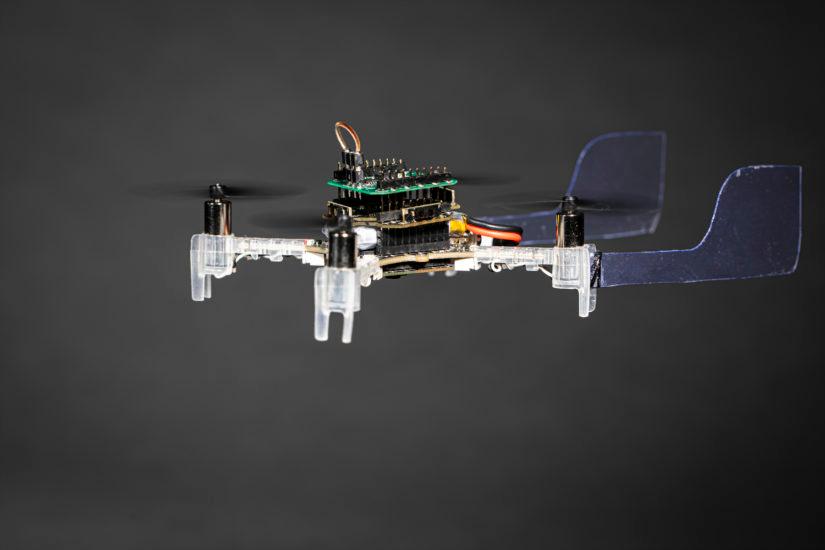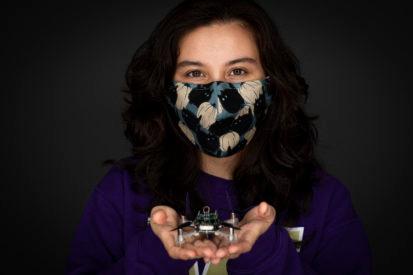UAVs May Be Unmanned, But They Soon May Not Be Un-Mothed
The Smellicopter Uses Live Moth Antennae to "Pilot" Its Missions

Mechanical engineering students completing doctoral degrees at the University of Washington (UW) are working with faculty advisors on what is likely a new type of hybrid eVTOL – an unmanned aerial vehicle (UAV) that uses antennae from live moths to navigate hazardous situations.
The moth antennae may be used to sniff out life-threatening hazards in places where robots cannot easily roam, such as unstable structures affected by natural disaster or locations where weight-bearing pressure might trigger explosions.
The Smellicopter: a New Lepidoptera Taking Flight

A team led by the University of Washington has developed Smellicopter: an autonomous drone that uses a live antenna from a moth to navigate toward smells. Smellicopter can also sense and avoid obstacles as it travels through the air. Shown here is a hawkmoth in front of the Smellicopter.
(Mark Stone/University of Washington)
The smellicopter may be the first pairing of a mechanical device with a live creature. While other eVTOLs and hybrid-powered VTOLs’ names are nature-inspired, such as Overair’s Butterfly, the smellicopter is not just inspired by nature, it incorporates it directly, actively, into the technology.
Scientists refrigerated the moths (of the Manduca sexta hawkmoth type) to anesthetize them before they surgically removed the antennae. After being separated from the live moth, the antennae can function for up to four hours.
Using a commercially available drone, the Crazyflie 2.1, the researchers added tiny wires to the antenna and connected one end to an electrical circuit to measure the average signal from all the antenna’s cells.
The study’s results, published in Bioinspiration & Biomimetics in October 2021, demonstrate “the sensitivity of a biological organism on a robotic platform where we can control its motion,” according to Melanie Anderson, the study’s lead author.

A team led by the University of Washington has developed Smellicopter: an autonomous drone that uses a live antenna from a moth to navigate toward smells. Shown here is lead author Melanie Anderson, a doctoral student of mechanical engineering, holding the Smellicopter.
(Mark Stone/University of Washington)
Ms. Anderson’s faculty advisor and co-author, Professor Thomas Daniel, explains: “Cells in a moth antenna amplify chemical signals. The moths do it really efficiently — one scent molecule can trigger lots of cellular responses, and that’s the trick. This process is super efficient, specific and fast.”
To test the setup’s effectiveness compared to human-made sensors, the research team wafted scents, such as floral scents and ethanol, into a wind tunnel and then recorded reaction time and the time needed to recover between puffs. The antennae were able to both react and recover more quickly than human-made sensors.
The smellicopter uses four infrared sensors to detect obstacles in its path. If something comes within 20 centimeters (about eight inches) of the drone, it changes direction following a preset cast-and-surge protocol.
Additional researchers and funding include: Joseph Sullivan, a UW electrical and computer engineering doctoral student, and Timothy Horiuchi, an electrical and computer engineering associate professor at the University of Maryland College Park, who are also co-authors.
Research was funded by the National Defense and Engineering Graduate Fellowship, the Washington Research Foundation, the Joan and Richard Komen Endowed Chair and the U.S. Air Force Office of Scientific Research with The Air Force Center of Excellence on Nature-Inspired Flight Technologies and Ideas.
Want to continue to stay up-to-date about the latest developments in the eVTOL industry? Subscribe to AeroCar Journal now. It’s FREE (for a limited time)! Join us on Twitter for the latest news, analysis, and insight about the eVTOL industry. AeroCarJ


